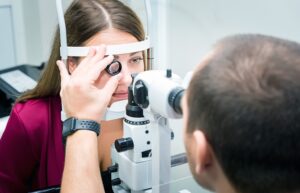
The Department of Transportation (DOT) physical exam is important for ensuring the safety of commercial drivers and those sharing the road with them. One of the key aspects of asheboro dot physical examination is the vision test, which evaluates a driver’s visual acuity and peripheral vision.
Understanding the DOT Vision Test
Visual acuity is paramount for safe driving. The DOT vision test measures a driver’s ability to see clearly and discern objects at varying distances. The primary goal is to ensure that drivers can spot road signs, potential hazards, and other vehicles from a distance. The specific standards for visual acuity are usually outlined in terms of Snellen acuity measurements, which are expressed as a fraction (e.g., 20/20).
- Visual Acuity Standard: The standard for passing the DOT vision test is typically 20/40 vision in each eye.
- Use of Corrective Lenses: Drivers who need glasses or contact lenses to achieve the required visual acuity can wear them during the test. However, if corrective lenses are necessary, the driver must have them while operating the commercial vehicle.
- Monovision Correction: Some drivers may have different visual acuity levels in each eye due to monovision correction (e.g., one eye for distance, one for reading). As long as the combined acuity meets the standard, this is generally acceptable.
Preparing for the Vision Test
- Regular Eye Examinations: Prior to the DOT physical, it’s crucial for drivers to undergo routine eye examinations with an optometrist or ophthalmologist. This helps ensure that any vision issues are addressed and corrected before the test.
- Wearing Corrective Lenses: If a driver requires corrective lenses, it’s important to wear them during the vision test. The examiner will assess vision with and without lenses, so having accurate correction is essential.
- Testing Peripheral Vision: While not as emphasized as visual acuity, the DOT physical also evaluates a driver’s peripheral vision. Adequate peripheral vision is vital for safe lane changes and detecting surrounding traffic.
- Understanding Eye Conditions: Familiarize yourself with common eye conditions that might affect your visual acuity, such as cataracts, glaucoma, or macular degeneration. If you have any of these conditions, discuss them with your healthcare provider.
Adequate visual acuity and peripheral vision are vital for identifying road signs, hazards, and other vehicles, especially in varied weather and road conditions. By understanding the standards, preparing through regular eye examinations, and addressing any vision issues with corrective measures, drivers can confidently navigate the DOT vision test and contribute to road safety.
Remember, maintaining good eye health and regularly visiting eye care professionals not only helps in passing the DOT vision test but also ensures your safety and the safety of others on the road.








